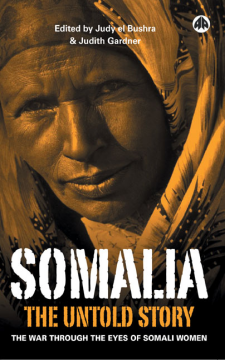
Additional Information
Book Details
Abstract
Somalia came to the world's attention in 1992 when television and newspapers began to report on the terrifyingly violent war and the famine that resulted. Half a million Somalis died that year, and over a million fled the country. Cameras followed US troops as they landed on the beaches at Mogadishu to lead what became an ill-fated UN intervention to end hunger and restore peace.
In this book, Somali women write and talk about the war, their experiences and the unacceptable choices they often faced. They explain clearly, in their own words, the changes, challenges – and sometimes the opportunities – that war brought, and how they coped with them.
Key themes include the slaughter and loss of men, who were the prime target for killings; rape and sexual violence as a weapon of war; changing roles in the family and within the pastoralist economy; women mobilising for peace; and leading social recovery in a war-torn society.
This book is not only an important record of women's experience of war, but also provides researchers and students of gender and conflict with rare first hand accounts highlighting the impact of war on gender relations, and women's struggle for equal political rights in a situation of state collapse.
'Shows the damage caused to society by the conflict, the breakdown of clan traditions and the way it impinged on women, and the use of rape and sexual violence by combatants'
Oxfam
Table of Contents
| Section Title | Page | Action | Price |
|---|---|---|---|
| Contents | v | ||
| Introduction Judy Gardner and Judy El Bushra | 1 | ||
| 1 Women's role in the pastoral economy | 24 | ||
| Testimony 1: Habiba Osman | 41 | ||
| 2 Traditions of marriage and the household | 51 | ||
| Testimony 2: Amina Sayid | 59 | ||
| 3 War crimes against women and girls | 69 | ||
| Testimony 3: A group view | 85 | ||
| Testimony 4: Shukri Hariir | 89 | ||
| Section 1: Changing roles and responsibilities in the family | 99 | ||
| 4 Domestic conflict in the diaspora - Somali women asylum seekers and refugees in Canada | 107 | ||
| 5 Crisis or opportunity? Somali women traders and the war | 116 | ||
| Testimony 5: Halimo Elmi | 127 | ||
| Section 2: Women mobilise for peace | 139 | ||
| 6 Women and peace-making in Somaliland | 142 | ||
| 7 Women, clan identity and peace-building | 153 | ||
| 8 Women's roles in peace- making in the Somali community in north eastern Kenya | 166 | ||
| Section 3: Women's rights, leadership and political empowerment | 175 | ||
| Testimony 6: Dahabo Isse | 179 | ||
| 9 Post- war recovery and participation | 189 | ||
| Testimony 7: Noreen Michael Mariano | 209 | ||
| Starlin Abdi Arush - a tribute | 215 | ||
| Afterword: political update, July 2003 | 220 | ||
| About the contributors | 223 | ||
| Appendices | 228 | ||
| Appendix 1: Chronology of Somalia's civil war | 228 | ||
| Appendix 2: Somalia in facts and figures | 236 | ||
| Appendix 3: Glossary | 238 | ||
| Appendix 4: Bibliography | 241 | ||
| Index | 247 |
